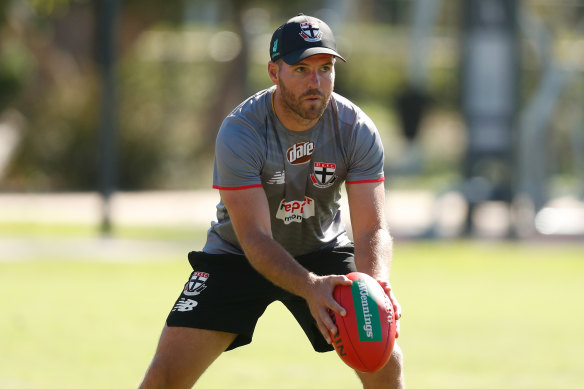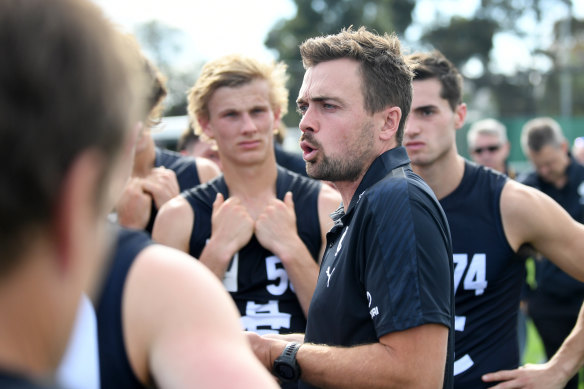Schneider, who was living in Sydney with a young family, watched as assistant coach wages dropped by 37 per cent while their workloads increased due to cuts to the football department soft cap. He took that on the chin as easily as he did when playing, but then as the world emerged from its COVID hiatus, he reassessed.
“We were sort of going backwards,” Schneider said.
“I loved coaching, really loved it and had to make a family decision. [I was] frustrated. The rules that came in with the soft cap really hurt and obviously your workload had to double too because we lost some important people to the business too.”
Schneider headed back to Lavington in country NSW, near where he grew up in Osborne, found a job with AgBoss, a farm product specialist, coached the local team in the Ovens and Murray League, helped out where needed with the Giants’ academy and, as a result, could not be happier.
He recognised that he would be better off outside the AFL because of the structural shifts in the industry that coaches interpret as an indication that the league does not value their role.
An AFL Coaches Association survey in 2022 revealed that the percentage of coaches – senior, assistants and development – who felt respected by the AFL had dropped from 70 per cent in 2019 to 19 per cent in 2022.
Similar falls were recorded when coaches were asked about work-life balance (60-26) and their capacity to sustain their current workload (70-33).
Discussions with multiple AFL coaches revealed significant dissatisfaction with how the AFL have treated football departments post-COVID.
They accepted the initial cut in the soft cap. But many, who commented off the record because they weren’t authorised to speak publicly, have watched with increasing anger as the rest of the football industry rebounded to pre-pandemic incomes while football departments were stuck in the back 50, hanging on. Many recruiters express the same disappointment as the coaching fraternity.
From $9.6 million in 2019 to $6.2 million during COVID, the soft cap was bumped up to $6.95 million and in 2024, the cap will sit at $7.2 million. Clubs can also claim exemptions by employing wellbeing professionals or Indigenous support staff while a minimum medical spend is compulsory. Spending on welfare can sit outside the cap too, stretching from $500,000 to more than $1.5 million.
Contracts have been tightened, too, so payouts are limited to between three and six months. Just 8 per cent of assistant coaches and 3 per cent of development coaches are eligible for a full payout if moved on before their contract ends. In an increasingly volatile profession, few safeguards exist.
Unless something shifts, the coaches might need the wellbeing programs as much as the players because the happiest people in the coaching profession seem to be ex-assistant coaches who left the AFL behind.
“I don’t miss it one bit,” said an ex-assistant coach, who now works in business and preferred to remain anonymous.
He is earning twice as much now as he did in the AFL, sees his family more and doesn’t have to deal with football being part of every social interaction. In fact, when he was an assistant, he rarely made it to an occasion during winter that wasn’t club-related.
His earning potential now is not capped either, with his effort and smarts rewarded.
That’s not the case for many assistant coaches who are often left sitting at the kitchen table on their rare days off, coding previous games or doing opposition analysis.

Ben McGlynn is no longer an assistant coach in the AFL system.Credit: AFL Photos
Soon after Ben McGlynn resigned from being an assistant coach after six years with St Kilda and a long playing career with Hawthorn and Sydney, he received a phone call from Daniel O’Keefe.
O’Keefe was at his dream job at Carlton, combining the posts of development and VFL coach. He loved the players and the people he worked with, but he wanted to pick McGlynn’s brains.
With a year left on his contract, O’Keefe was contemplating stepping out of the AFL despite having worked so hard to get there.
His 30-minute chat with McGlynn crystallised his thinking that it was not possible to meet the demands of his job while raising a young family.
“I was a young coach who sacrificed a lot to get there … everything could not have been more perfect, the club, the people there, the success that is hopefully about to come, everything was incredibly amazing. I had a year left on my contract, and I still couldn’t stay there,” O’Keefe said.
Both McGlynn and O’Keefe are full of praise for their respective clubs. They emphasise the fact they could not have done any more to support them.

Daniel O’Keefe during his time as Carlton’s VFL coach.Credit: AFL Photos
O’Keefe, who landed a job with Warrnambool Football Club where he coaches, still hopes that when his children are older, he might get another chance to return to the AFL, such is his passion for coaching.
But right now, having shown his work ethic while working as a sales manager at News Corp while coaching the Geelong Falcons to chase his dream, he has had to step back from the VFL/development coaching job.
“There is no way around the demand for what that role needs from you regardless of how amazing the footy club is in trying to help you and support you,” O’Keefe said.
“[It’s] just that the demand of that role means you are needed in the morning, during the day and at night.”
It’s made the once-attractive thought of entering the AFL as an assistant coach post-playing much less appealing for former stars. If nothing shifts to change that perception, it will be the industry and the players who suffer.
“I let the Saints know [my decision] was nothing to do with the people inside the football club or the players,” McGlynn said. “It was probably more what the industry was doing to my family.
He returned to Mildura where he became head coach at the Footy Star Academy, teaching juniors.
“We couldn’t be happier with our decision,” McGlynn said.
The AFL Coaches Association obviously wants the soft cap to increase, so more resources can be found to support the experienced assistants and assist their development.
They are also pushing for a transition or retirement fund, a marketing allowance that would enable those coaches with commercial appeal to increase their income and a shift in thinking around termination clauses to give clubs reason to pause before making mass changes.
They know the AFL trades on the commitment of coaches to the profession and the inherent satisfaction they derive from seeing young men and women, many who share dinner tables with their families, grow into good footballers and mature people. They also enjoy being part of an elite competition that tests their mettle and gives them an adrenalin rush available to few other professions.
The AFL, which acted when spending was out of control and inflationary, and now views the measure as assisting competitive balance, did not want to comment on the reasons behind the ongoing need to keep the cap tight.
Loading
But the coaches don’t like being treated like mugs. And that, right now, is how those who expressed their feelings off the record to this masthead believe they are being treated. If more resources were allocated to support their jobs and creative ideas that challenged conventional thinking on what their roles might become were backed, the profession could regain its appeal.
Coaches’ association CEO Alastair Nicholson says taking assistant coaches for granted is dangerous for the industry. They are, after all, critical developers of playing lists in which each club invests $13 million, remembering that football performance the key driver of club revenue.
“Everyone jumped in the rescue boat when needed [during COVID]. The others have rowed away from that, but the coaching profession has been left behind,” Nicholson said.
“It is important for the game. We want the good ones staying in as long as they can and becoming good senior coaches.”
Keep up to date with the best AFL coverage in the country. Sign up for the Real Footy newsletter.
